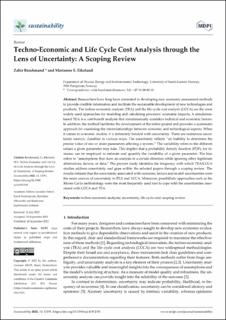| dc.contributor.author | Barahmand, Zahir | |
| dc.contributor.author | Eikeland, Marianne Sørflaten | |
| dc.date.accessioned | 2022-10-18T13:06:28Z | |
| dc.date.available | 2022-10-18T13:06:28Z | |
| dc.date.created | 2022-09-26T14:54:06Z | |
| dc.date.issued | 2022 | |
| dc.identifier.citation | Barahmand, Z. & Eikeland, M. S. (2022). Techno-Economic and Life Cycle Cost Analysis through the Lens of Uncertainty: A Scoping Review. Sustainability, 14(19), Artikkel 12191. | en_US |
| dc.identifier.issn | 2071-1050 | |
| dc.identifier.uri | https://hdl.handle.net/11250/3026707 | |
| dc.description.abstract | Researchers have long been interested in developing new economic assessment methods to provide credible information and facilitate the sustainable development of new technologies and products. The techno-economic analysis (TEA) and the life cycle cost analysis (LCCA) are the most widely used approaches for modeling and calculating processes’ economic impacts. A simulation-based TEA is a cost-benefit analysis that simultaneously considers technical and economic factors. In addition, the method facilitates the development of the entire project and provides a systematic approach for examining the interrelationships between economic and technological aspects. When it comes to economic studies, it is intimately bonded with uncertainty. There are numerous uncertainty sources, classified in various ways. The uncertainty reflects “an inability to determine the precise value of one or more parameters affecting a system.” The variability refers to the different values a given parameter may take. This implies that a probability density function (PDF), for instance, can be employed to estimate and quantify the variability of a given parameter. The bias refers to “assumptions that skew an analysis in a certain direction while ignoring other legitimate alternatives, factors, or data.” The present study identifies the frequency with which TEA/LCCA studies address uncertainty and gaps within the selected papers through a scoping review. The results indicate that the uncertainty associated with economic factors and model uncertainties were the main sources of uncertainty in TEA and LCCA. Moreover, possibilistic approaches such as the Monte Carlo methodology were the most frequently used tool to cope with the uncertainties associated with LCCA and TEA. | en_US |
| dc.language.iso | eng | en_US |
| dc.rights | Navngivelse 4.0 Internasjonal | * |
| dc.rights.uri | http://creativecommons.org/licenses/by/4.0/deed.no | * |
| dc.title | Techno-Economic and Life Cycle Cost Analysis through the Lens of Uncertainty: A Scoping Review | en_US |
| dc.type | Peer reviewed | en_US |
| dc.type | Journal article | en_US |
| dc.description.version | publishedVersion | en_US |
| dc.rights.holder | © 2022 by the authors. | en_US |
| dc.source.volume | 14 | en_US |
| dc.source.journal | Sustainability | en_US |
| dc.source.issue | 19 | en_US |
| dc.identifier.doi | https://doi.org/10.3390/su141912191 | |
| dc.identifier.cristin | 2055583 | |
| dc.source.articlenumber | 12191 | en_US |
| cristin.ispublished | true | |
| cristin.fulltext | original | |
| cristin.qualitycode | 1 | |

